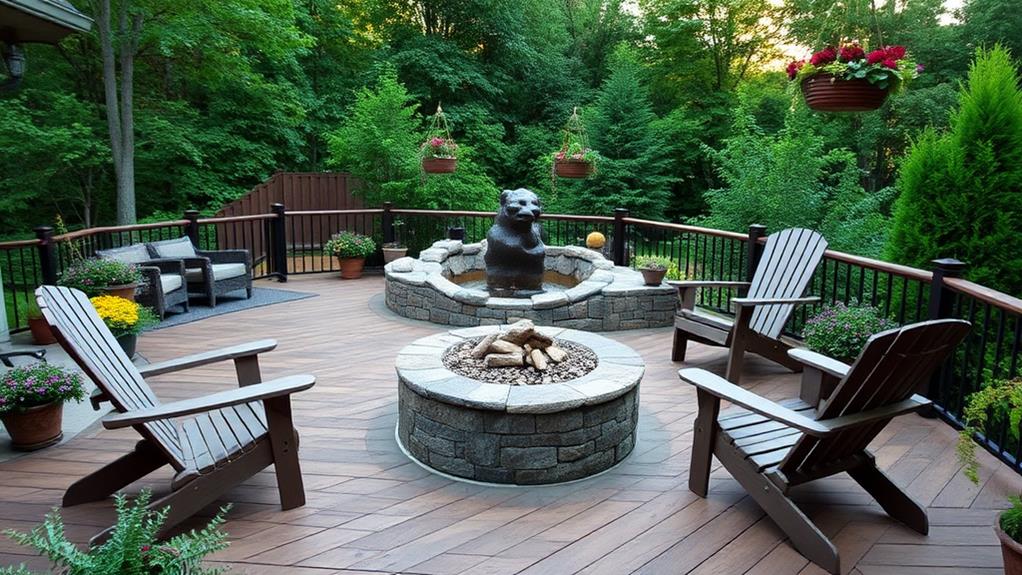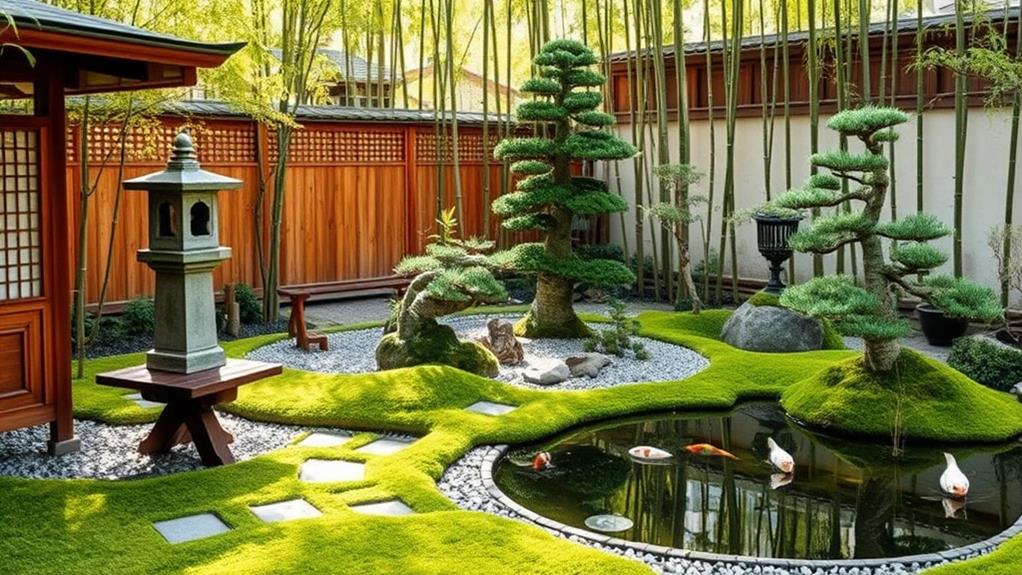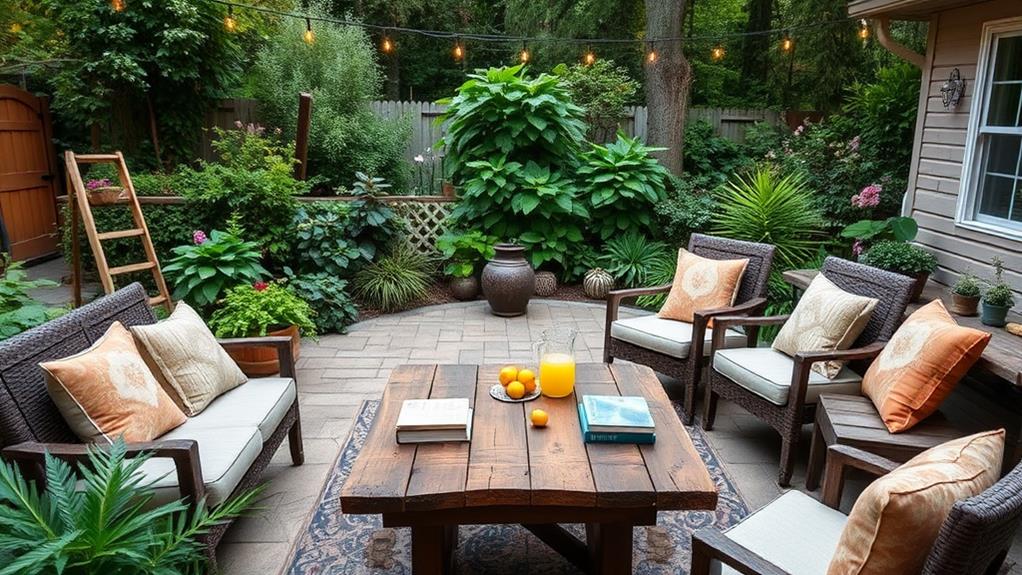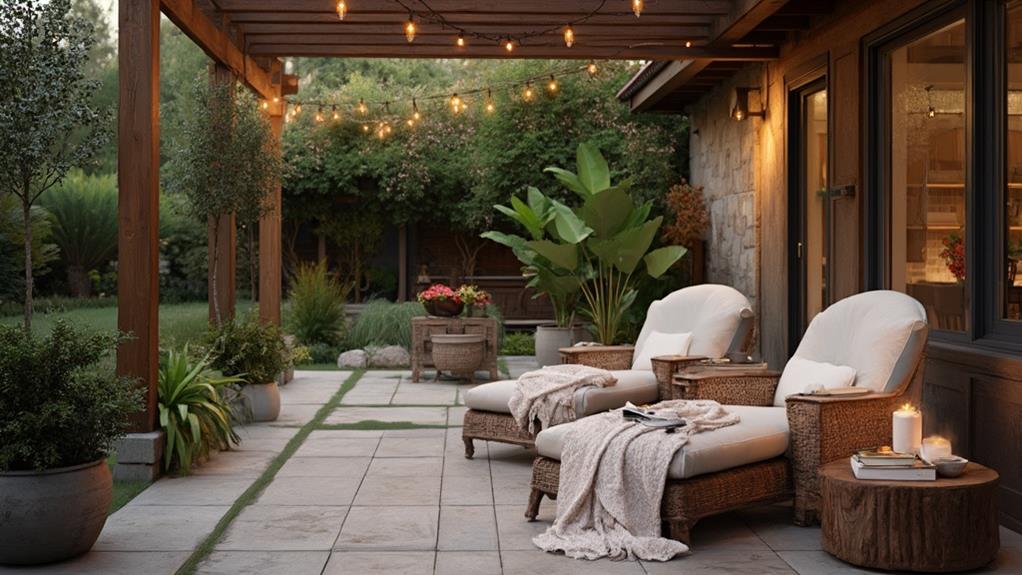Creating tech-free outdoor living spaces offers a sanctuary from the constant digital distractions of modern life. These unplugged zones foster genuine human connections, reduce stress, and promote physical activity. Designing such spaces involves selecting suitable locations, incorporating natural elements, and encouraging face-to-face interactions. Mindfulness practices, outdoor activities, and proper lighting enhance the experience. Balancing technology with nature allows for occasional modern conveniences while maintaining a primarily unplugged environment. By establishing clear boundaries and integrating interactive elements, these spaces become havens for relaxation, creativity, and social interaction. Discover how to transform your outdoor area into a rejuvenating retreat from the digital world.
Benefits of Unplugged Outdoor Spaces

One of the most significant advantages of unplugged outdoor living spaces is their ability to foster genuine human connection. Without the constant distractions of smartphones, tablets, or laptops, people are more likely to engage in meaningful conversations and activities with family and friends. These tech-free zones encourage face-to-face interactions, promoting deeper relationships and shared experiences.
Unplugged outdoor spaces also offer numerous mental health benefits. By disconnecting from digital devices, individuals can reduce stress, anxiety, and information overload. The natural environment provides a calming atmosphere, allowing for improved focus, creativity, and mindfulness. Spending time in these spaces can lead to increased relaxation and better overall well-being.
Furthermore, tech-free outdoor areas promote physical activity and healthier lifestyles. Without screens to occupy their attention, people are more likely to engage in outdoor activities such as gardening, sports, or simply enjoying nature. This increased physical activity can lead to improved fitness levels, better sleep patterns, and enhanced overall health. Additionally, unplugged spaces encourage children to develop important social skills, imagination, and problem-solving abilities through unstructured play and exploration.
Designing Your Tech-Free Zone
Creating an inviting tech-free outdoor space requires thoughtful planning and design. Begin by selecting a suitable location that offers privacy and minimal distractions. Consider natural elements like trees, shrubs, or fences to create a sense of seclusion.
Choose comfortable, weather-resistant furniture that encourages relaxation and conversation. Incorporate versatile seating options such as loungers, chairs, and benches to accommodate various activities. Add soft cushions and throws for extra comfort.
Implement proper lighting to extend the usability of your space into the evening hours. Use a combination of ambient, task, and accent lighting, such as string lights, lanterns, or solar-powered fixtures. Be mindful of light pollution and opt for warm, soft lighting that enhances the calming atmosphere.
Incorporate natural elements like water features, potted plants, or a small garden to create a serene environment. Consider adding a fire pit or outdoor fireplace for warmth and ambiance during cooler evenings.
Designate areas for specific activities like reading, meditation, or outdoor games. Provide storage solutions for books, games, and other non-electronic entertainment options. By carefully curating your tech-free zone, you can create a space that promotes relaxation, connection, and mindfulness.
Natural Elements for Relaxation

Nature's soothing elements play a crucial role in creating a relaxing outdoor living space. Incorporating these natural features can significantly enhance the atmosphere and promote a sense of calm in your tech-free zone. Water elements, such as fountains or small ponds, provide a tranquil ambiance with their gentle sounds and movement. The soft bubbling or trickling of water can mask urban noise and induce relaxation.
Greenery is another essential component. Lush plants, trees, and shrubs not only purify the air but also create a sense of privacy and connection to nature. Consider vertical gardens or potted plants for smaller spaces.
Natural stone elements, like rock gardens or gravel paths, add texture and visual interest while grounding the space. Incorporate comfortable seating made from natural materials such as wood, wicker, or rattan. Add soft cushions and throws for extra comfort. Use warm, soft lighting with candles or solar-powered lanterns to create a cozy atmosphere as evening falls.
Encouraging Face-to-Face Interactions
Designed to foster genuine connections, unplugged outdoor living spaces offer the perfect backdrop for meaningful face-to-face interactions. By removing digital distractions, these areas encourage people to engage in direct conversation, strengthening relationships and promoting social cohesion. To facilitate this, consider incorporating circular seating arrangements or conversation pits that naturally bring people together.
Communal features like outdoor kitchens, fire pits, or game areas can serve as focal points for gatherings, prompting shared experiences and discussions. Implementing comfortable seating options, such as cushioned benches or Adirondack chairs, invites people to linger and converse. Soft lighting, like string lights or lanterns, creates a warm ambiance that extends socializing into the evening hours.
For larger spaces, consider creating multiple conversation zones to accommodate different group sizes and activities. Incorporating elements that spark conversation, such as unique sculptures, water features, or themed gardens, can provide natural conversation starters. By thoughtfully designing these tech-free outdoor spaces, you create an environment that nurtures human connection and encourages people to rediscover the art of face-to-face communication in our increasingly digital world.
Mindfulness in the Garden

As outdoor spaces increasingly become refuges from digital overwhelm, gardens offer unique opportunities for mindfulness practices. Cultivating a garden can be a meditative experience, allowing individuals to connect with nature and focus on the present moment. The act of planting, weeding, and tending to plants requires concentration and attention to detail, naturally promoting mindfulness.
Creating dedicated spaces for meditation or yoga within the garden can further enhance mindfulness practices. These areas can be designed with calming elements such as water features, wind chimes, or aromatic plants to engage the senses and promote relaxation. Incorporating natural materials like stone or wood can ground individuals and foster a deeper connection to the environment.
Mindful gardening techniques, such as observing plant growth, practicing gratitude for the garden's bounty, and engaging in sensory experiences like touching soil or smelling flowers, can deepen one's awareness and presence. By encouraging regular mindfulness sessions in the garden, individuals can develop a habit of unplugging from technology and tuning into their surroundings. This practice not only benefits mental health but also nurtures a greater appreciation for the natural world.
Outdoor Activities Without Devices
Engaging in outdoor activities without devices opens up a world of possibilities for genuine connection and sensory experiences. Unplugged outdoor pursuits encourage active participation and mindfulness, allowing individuals to fully immerse themselves in their surroundings.
Traditional yard games like horseshoes, bocce ball, or croquet provide opportunities for friendly competition and social interaction. Nature-based activities such as birdwatching, stargazing, or identifying local flora and fauna foster a deeper appreciation for the environment. Physical activities like yoga, tai chi, or stretching in the fresh air promote both mental and physical well-being.
For those seeking creative outlets, outdoor painting, sketching, or nature journaling offer ways to capture the beauty of the surroundings. Gardening, whether tending to flowers or cultivating vegetables, provides a hands-on connection to the earth and a sense of accomplishment. Building projects like birdhouses, wind chimes, or outdoor furniture engage problem-solving skills and result in functional additions to the space.
Ultimately, device-free outdoor activities encourage individuals to slow down, engage their senses, and cultivate meaningful connections with nature and others, promoting a healthier, more balanced lifestyle.
Lighting for Unplugged Evenings

Thoughtful lighting solutions play a crucial role in creating inviting and functional unplugged outdoor living spaces for evening use. When designing lighting for tech-free zones, focus on soft, ambient illumination that enhances the natural atmosphere without overwhelming it.
Solar-powered lanterns and pathway lights offer an eco-friendly option that requires minimal maintenance. These can be strategically placed along walkways, near seating areas, or hung from trees to provide gentle illumination.
For a more rustic ambiance, consider using string lights or fairy lights, which can be draped across pergolas, fences, or tree branches to create a warm, inviting glow.
Candles and oil lamps add a traditional touch and create a cozy atmosphere perfect for unplugged gatherings. Use citronella candles or torches to also help repel insects. For safety and convenience, battery-operated flameless candles are an excellent alternative.
To highlight specific features or create focal points, use low-voltage landscape lighting. Spotlights can accentuate trees, water features, or architectural elements, while well lights can illuminate plants or structures from below. Remember to use warm white or amber bulbs to maintain a relaxing atmosphere conducive to unplugged activities.
Balancing Technology and Nature
Striking the right balance between technology and nature in unplugged outdoor living spaces requires careful consideration and intentional design choices. While the goal is to create a tech-free environment, some modern conveniences can enhance the outdoor experience without detracting from nature's essence.
Incorporate subtle technological elements that blend seamlessly with the natural surroundings. For example, use solar-powered lighting or weatherproof speakers disguised as rocks to provide ambiance without obvious tech intrusion. Consider installing a retractable projector screen for occasional movie nights under the stars, which can be hidden when not in use.
Prioritize natural materials and biophilic design principles to maintain a connection with nature. Use wood, stone, and plants extensively in your outdoor space. Create designated areas for tech-free activities such as meditation, reading, or stargazing. Implement a device storage solution, like a stylish lockbox, to encourage guests to disconnect during their time outdoors.
Ultimately, the key is to strike a balance that allows for occasional technological conveniences while preserving the overall natural and unplugged atmosphere of the outdoor living space.
Maintaining a Tech-Free Environment

Preserving a tech-free environment in outdoor living spaces requires deliberate effort and creativity. To maintain this sanctuary from digital distractions, establish clear boundaries and communicate expectations with family members and guests. Consider implementing a device check-in station at the entrance to your outdoor area, where smartphones and tablets can be safely stored.
Create engaging alternatives to technology by incorporating interactive elements such as board games, puzzles, or outdoor activities like horseshoes or bocce ball. Encourage conversation and social interaction by arranging seating in circular or face-to-face configurations. Integrate natural elements that promote relaxation and mindfulness, such as water features, gardens, or bird feeders.
To resist the temptation of technology, ensure that your outdoor space is self-sufficient. Install adequate lighting for evening use, and consider adding a small refrigerator or cooler for refreshments. Regularly maintain and update your tech-free zone to keep it appealing and functional. By consistently enforcing the no-technology rule and providing engaging alternatives, you can cultivate a space that fosters genuine connections, relaxation, and appreciation for the natural world.
Frequently Asked Questions
How Do I Enforce Tech-Free Rules With Resistant Family Members or Guests?
To enforce tech-free rules with resistant family members or guests, establish clear expectations, lead by example, and create engaging alternatives. Implement consequences for rule-breaking, and communicate the benefits of unplugging. Provide designated tech-use areas and times if necessary.
Can I Incorporate Smart Outdoor Lighting Without Compromising the Tech-Free Concept?
Is smart lighting a bridge too far for a tech-free space? While it may seem contradictory, discreetly installed smart outdoor lighting can enhance ambiance without compromising the unplugged concept, provided it's controlled remotely and doesn't require user interaction.
What Are Some Weather-Resistant Storage Solutions for Outdoor Books and Games?
For weather-resistant storage of outdoor books and games, consider waterproof storage boxes, sealed cabinets, or outdoor storage benches. Look for materials like marine-grade plastic, treated wood, or powder-coated metal. Ensure proper ventilation to prevent mold and mildew growth.
How Can I Soundproof My Tech-Free Zone From Noisy Neighbors or Street Sounds?
To soundproof your outdoor space from noisy neighbors or street sounds, consider installing acoustic fencing, strategically placing dense vegetation, using outdoor curtains or screens, and incorporating water features to mask unwanted noise. Sound-absorbing materials and white noise machines can also help.
Are There Any Tech-Free Outdoor Activities Suitable for People With Limited Mobility?
Ironically, in our tech-obsessed world, there's a wealth of low-tech outdoor activities for those with limited mobility. Bird watching, container gardening, sketching, and star gazing offer engaging experiences without requiring extensive physical exertion or technological interference.
Conclusion
In the digital age, creating tech-free outdoor spaces offers a sanctuary from the constant stream of information and notifications. These unplugged havens, like oases in a desert of screens, provide numerous benefits for mental health, social connections, and overall well-being. By thoughtfully designing and maintaining these areas, individuals can cultivate environments that promote mindfulness, encourage face-to-face interactions, and foster a deeper connection with nature. Ultimately, balancing technology use with intentional unplugged time outdoors can lead to a more fulfilling and balanced lifestyle.

